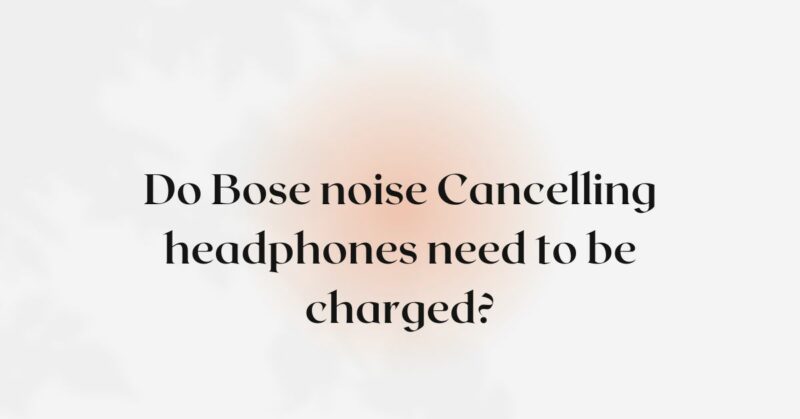Bose noise cancelling headphones have revolutionized the audio industry by providing an immersive listening experience with their advanced noise cancellation technology. As a user, you may be curious about whether these headphones need to be charged to enjoy their noise cancelling capabilities. In this article, we will explore the charging requirements of Bose noise cancelling headphones and shed light on their dependence on battery power. By understanding these factors, you can optimize your usage and experience the full benefits of noise cancellation.
- Active Noise Cancellation Technology: Bose noise cancelling headphones are equipped with advanced active noise cancellation (ANC) technology. This technology relies on internal microphones that pick up ambient sounds and generate an equal and opposite sound wave to cancel out the unwanted noise. To power this sophisticated noise cancelling process, the headphones require a dedicated power source in the form of a built-in battery.
- Battery-Powered Functionality: The noise cancellation feature of Bose headphones is battery-dependent. The built-in battery powers the ANC circuitry, allowing the headphones to actively counteract external noise and provide a serene listening experience. Without a charged battery, the ANC functionality will not work, and the headphones will function in a passive mode without noise cancellation.
- Importance of Battery Charge: To enjoy the full benefits of noise cancellation, it is crucial to charge your Bose headphones before use. A fully charged battery ensures that the noise cancelling feature operates at its optimal performance, effectively reducing external noise and providing a tranquil environment for your audio enjoyment. Charging the headphones also enables you to utilize other features such as Bluetooth connectivity and onboard controls that enhance your overall experience.
- Battery Life and Usage Duration: Bose noise cancelling headphones offer a specified battery life, which indicates the duration the headphones can operate on a single charge with active noise cancellation enabled. The actual battery life may vary based on factors such as volume levels, usage of other features, and the specific headphone model. Regular charging and monitoring of the battery level allow you to estimate usage duration and plan your listening sessions accordingly.
- Charging Methods and Indicators: Charging Bose noise cancelling headphones is a straightforward process. The headphones come with a charging cable that connects to a compatible power source, such as a wall adapter, computer USB port, or portable power bank. Many Bose headphone models also feature LED indicators that display the charging progress, providing real-time information about the battery status. These indicators help you monitor the charging process and ensure that the headphones are ready for use when needed.
- Battery Conservation and Power Management: To optimize the battery life and prolong the usage duration of your Bose noise cancelling headphones, it is advisable to practice effective power management. This includes turning off the ANC feature when it is not required, adjusting volume levels to an optimal range, and utilizing power-saving modes if available. These measures help conserve battery power and extend the overall usage time.
- Battery Health and Longevity: Bose headphones, like many electronic devices, utilize lithium-ion batteries. Lithium-ion batteries have a limited lifespan and degrade over time. However, Bose headphones are designed with sophisticated battery management systems that protect against overcharging and optimize battery health. It is important to follow recommended charging practices, avoid extreme temperatures, and periodically cycle the battery to maintain its longevity.
- Battery Replacement: Over time, the battery in your Bose noise cancelling headphones may lose its maximum capacity, resulting in reduced usage duration. If you experience significant battery degradation, Bose provides battery replacement services or offers options to replace the entire headphone unit. This ensures that you can continue to enjoy the noise cancelling capabilities of Bose headphones even after the original battery’s lifespan.
Conclusion: Bose noise cancelling headphones require charging to power their active noise cancellation technology and provide the immersive listening experience they are known for. The battery-powered functionality enables the headphones to counteract external noise and create a peaceful environment for audio enjoyment. Regular charging, effective power management, and battery health considerations play crucial roles in optimizing the performance and longevity of your Bose noise cancelling headphones. By understanding the charging requirements and implementing recommended practices, you can fully embrace the benefits of noise cancellation and elevate your audio experiences to new heights.


